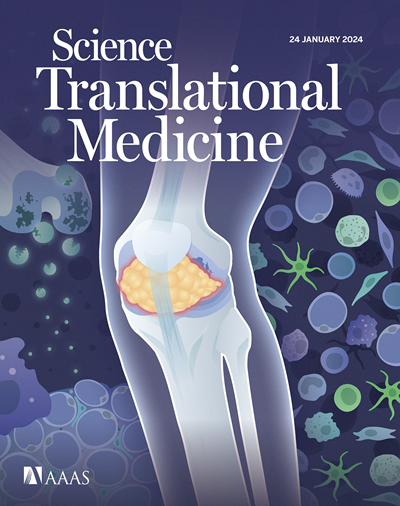免疫调节纳米颗粒重建脾脏胰岛移植研究
IF 15.8
1区 医学
Q1 CELL BIOLOGY
引用次数: 0
摘要
胰岛移植是治疗胰岛素依赖型糖尿病的一种很有前途的方法。然而,免疫排斥和血管化不足阻碍了移植胰岛的存活和功能。本研究显示,在不同程度的免疫抑制下,将血管化和功能良好的小鼠和大鼠胰岛移植到非免疫抑制的啮齿动物的生物材料重塑的脾脏中,并将人胰岛移植到非人灵长类动物(NHPs)的重塑脾脏中。我们发现有证据表明,魔芋葡甘聚糖修饰的二氧化硅纳米颗粒(KSiNPs)将脾脏重塑为一个富含细胞外基质(ECM)的免疫抑制生态位,以支持同质或异质胰岛的存活。移植胰岛的改建脾脏显示改善移植,新血管形成,和功能和恢复normoglycemia在链脲霉素(STZ)全身的1型糖尿病模型小鼠和猴,与稳定的小鼠的胰岛素和c肽分泌90天,猕猴为28天。在b超引导下,注射KSiNP并将胰岛移植到猕猴脾脏内是临床前可行的。这些发现强调了脾组织重塑在支持移植胰岛存活和功能方面的安全性和有效性,为治疗1型糖尿病(T1DM)提供了一个有希望的策略。本文章由计算机程序翻译,如有差异,请以英文原文为准。
Islet transplantation in immunomodulatory nanoparticle–remodeled spleens
Islet transplantation is a promising therapy for insulin-dependent diabetes. However, immune rejection and insufficient vascularization hinder the survival and function of transplanted islets. Here, we show effective engraftment of vascularized and functional mouse and rat islets transplanted into biomaterial-remodeled spleens of nonimmunosuppressed rodents and human islets transplanted into the remodeled spleens of nonhuman primates (NHPs) on varying degrees of immunosuppression. We found evidence that konjac glucomannan–modified silica nanoparticles (KSiNPs) remodeled the spleen into an extracellular matrix (ECM)–rich, immunosuppressive niche to support the survival of syngeneic or xenogeneic islets. Transplanted islets in the remodeled spleens showed improved engraftment, neovascularization, and functionality and restored normoglycemia in streptozotocin (STZ)–induced type 1 diabetic models in the mice and macaques, with stable insulin and C-peptide secretion in mice for 90 days and macaques for 28 days. KSiNP injection and islet transplantation into macaque spleens under B-ultrasound guidance were preclinically feasible. These findings highlight the safety and effectiveness of spleen tissue remodeling in supporting the survival and function of transplanted islets, providing a promising strategy for treating type 1 diabetes mellitus (T1DM).
求助全文
通过发布文献求助,成功后即可免费获取论文全文。
去求助
来源期刊

Science Translational Medicine
CELL BIOLOGY-MEDICINE, RESEARCH & EXPERIMENTAL
CiteScore
26.70
自引率
1.20%
发文量
309
审稿时长
1.7 months
期刊介绍:
Science Translational Medicine is an online journal that focuses on publishing research at the intersection of science, engineering, and medicine. The goal of the journal is to promote human health by providing a platform for researchers from various disciplines to communicate their latest advancements in biomedical, translational, and clinical research.
The journal aims to address the slow translation of scientific knowledge into effective treatments and health measures. It publishes articles that fill the knowledge gaps between preclinical research and medical applications, with a focus on accelerating the translation of knowledge into new ways of preventing, diagnosing, and treating human diseases.
The scope of Science Translational Medicine includes various areas such as cardiovascular disease, immunology/vaccines, metabolism/diabetes/obesity, neuroscience/neurology/psychiatry, cancer, infectious diseases, policy, behavior, bioengineering, chemical genomics/drug discovery, imaging, applied physical sciences, medical nanotechnology, drug delivery, biomarkers, gene therapy/regenerative medicine, toxicology and pharmacokinetics, data mining, cell culture, animal and human studies, medical informatics, and other interdisciplinary approaches to medicine.
The target audience of the journal includes researchers and management in academia, government, and the biotechnology and pharmaceutical industries. It is also relevant to physician scientists, regulators, policy makers, investors, business developers, and funding agencies.
 求助内容:
求助内容: 应助结果提醒方式:
应助结果提醒方式:


